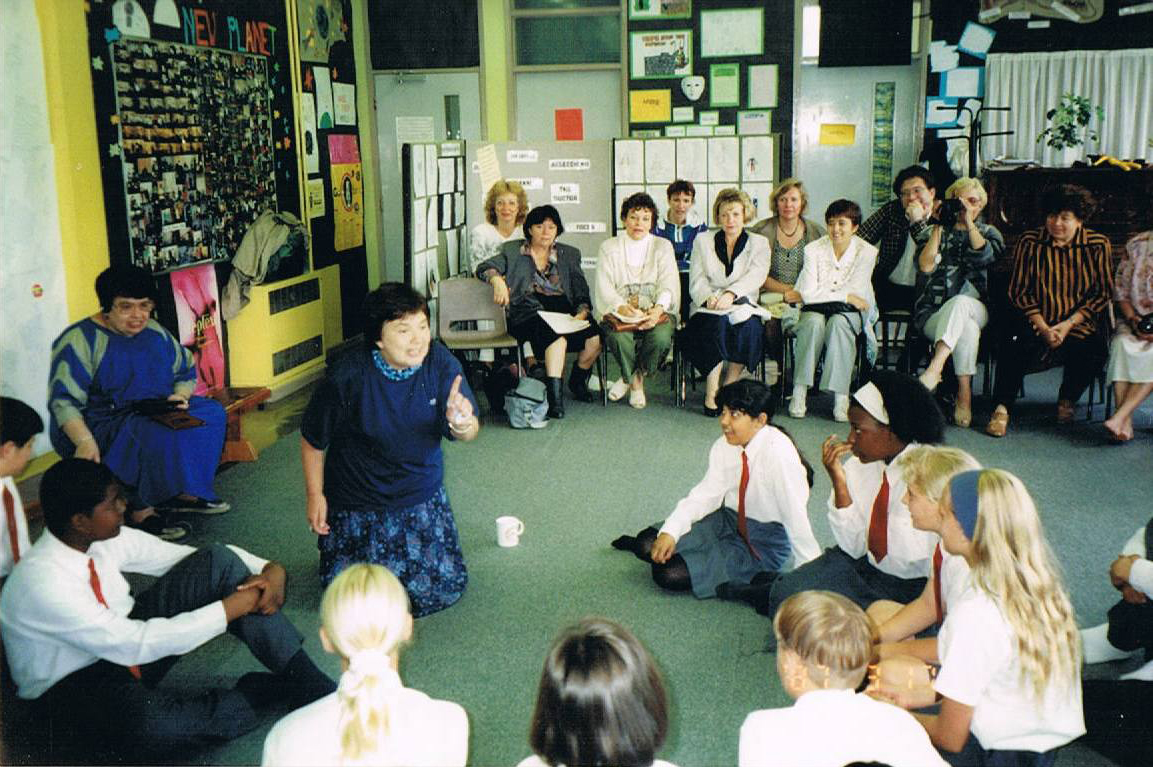Ãëàâíàÿ
Îá ýòîì ñàéòå
Íåìíîãî î ñåáå
Ñòèõè
Êíèãè
Îäíà ïüåñà
Ñêàçî÷íûé àíãëèéñêèé
Âûñòóïëåíèÿ
Èíòåðâüþ
Äëÿ ãàçåò1990 A story about storytelling
1991 Over here
1991 How to tell tall stories
1991 Empty shelves and English
1992 Storytelling in practice
1996 "- Çàêðîéòå çà ìíîé ðîò!"
1997 "- Âû îáîçâàëè ìåíÿ ïîýòåññîé?"
1998 "-ß âñåõ ëþáëþ, è ìíå âñåõ î÷åíü æàëêî"
1999 Î Ðåíàòå, Ìóõàðìñå è ïëàòêå õîáîòîâîì
2004 Ðåíàòà Ìóõà: íà÷àëî ñëåäóåò..
2005 Ïòè÷üè ïðàâà: ïðûãíóòü ñ ïàðàøþòîì ââåðõ...
Íà òåëåâèäåíèè
Íà ðàäèî
×òî áûëî â ãàçåòàõ
Ãëàçàìè äðóçåé

Renata Tkachenko A story about story-telling (from the personal experience of a foreign language teacher)
Ñ ó÷èòåëÿìè è ó÷åíèêàìè â îäíîé èç àíãëèéñêèõ øêîë
ELT REVIEW, No.2 Autumn 1990 The British Council
“… story-telling – that most compelling
and ancient of all human activities.”
J. Morgan and M.Rinvolucri
Ðóññêèé ïåðåâîä ÷èòàòü çäåñü.
Many years ago when I first began to tell British fairy-tales and stories in my lessons, I was quite unaware that I was using story-telling. The reason for this is that story-telling as a teaching method is not practiced in my country. Of course we have a wealth of wonderful fairy-tales, stories and legends many of which are in Britain, and Russian parents, like parents all over the world, tell their children fairy-tales at bedtime.

However, story-telling used by a language teacher within the framework of a particular teaching activity with a specific teaching aim is not, as far as I know, a method practiced in our schools. Even the term “story-telling” has no equivalent in Russian, so that I actually use the English term in Russian.
Before I launched myself into what turned out to be story-telling I had serious doubts about it. I enjoyed Kipling’s Just So Stories immensely and was eager to introduce my students to them. But these were fairy-tales and I was tutoring adult learners. On top of this, much of the vocabulary and grammar was unfamiliar to my students, but I did not want to fall back on translation and thus destroy the charm of the original. Still “one fine morning”(and not a very fine lesson!) I put aside Comrade Petrov (the traditional college-text hero) and said: “Hear and attend and listen, for this befell and behappened and became and was when all the tame animals were wild. The dog was wild and the horse was wild…”what happens next in Kipling’s story is well-known. As soon as the students heard the first sentence, their eyes lit up. A few moments later they were joining in, repeating phrases after me, miming actions and scenes.
While the story was in progress they ceased to be listeners and viewers in the story-telling session and became instead participants, characters, co-narrators and even co-authors. More importantly there emerged in the classroom a spontaneous communication in which both the teacher and the students were actively involved and interested in what was going on and in each other, which, as every language teacher knows, is the sine qua non of any teaching. Moreover the students picked up the fact that I myself enjoyed the story and they shared my enjoyment.
a Criteria for selecting stories
Thereafter this became the basic though not the only criterion which I used to select futher story-telling material: to tell stories that I enjoyed and wanted others to enjoy.
But to tell stories only for the sake of enjoyment is a luxury a teacher can hardly afford. More reliable and objective criteria are needed. On the basis of my experience I have developed certain criteria for selecting story-telling material which I now venture to suggest to those interested in this method. Apart from being enjoyable the text for story-telling ought:
- to be written in natural memorable language with strong rhythm, cadence and alliteration;
- to approximate to the requirements of the syllabus;
- to be suited in some degrees to the learner’s standard of proficiency. In my experience the learners ought to be familiar with at least seventy to seventy-five per cent of the vocabulary and most of the grammar structures in the text. If one has to explain too many items or grammatical structures the entire process shifts from being text-and pulip-centred to being teacher centred;
- to be cumulative and contain a lot of repetition. The repetitive aspect allows the teacher to “step aside” and give the initiative to the pupils after two or three repetitions. The accumulative aspect gives the story momentum, retaining the pupil’s interest. An indispensable element of this type is a repetitive phrase which may have cumulative structure (“Mother, there is a lion in the meadow”; “Mother, there is a big yellow lion in the meadow”; “Mother, there is a big, roaring, yellow, whiskery lion in the meadow” in A Lion in the Meadow by Margaret Mahy. Or, they may be versions/variants of the same idea expressed in different syntactic frameworks such as the famous suspenders in Kipling’s How the Whale Got His Throat which mesmerized my students (“you must not forget the suspenders”; “you must particularly remember the suspenders”; “…and the suspenders which you must not forget”; “have you forgotten the suspenders?”; “now you know why you were not to forget the suspenders”);
- to contain short dialogue exchanges to stimulate speech activity, to provide for acting out but preferably not more than two to four exchanges so that more pupils could take part. The mini-dialogues from Mr Gumpy’s Outing by John Burningham are an example;
- to be dynamic with action prevailing over description;
- to contain vocabulary which is concrete and easily demonstrable;
- to have a rhyme or an action song and if not it should be the teacher’s job to find some songs or verses to accompany his/her story-telling. Such songs or poems if well-chosen not only make the story more memorable and may be used for introducing new vocabulary, but they will help to prevent mental boredom which repetition may otherwise lead to. (I use “Old MacDonald had a farm” to go with Mr Gumpy’s Outing, “Little Arabella Miller found in the wood a caterpillar’ to go with The Very Hungry Caterpillar);
- to contain some real descriptions of British life and culture;
- to be short enough to be told in one session. However, in my opinion, there are certain advantages if you are teaching a foreign language in telling a story over two sessions. By breaking off at an interesting point you have an excellent and natural opportunity for beginning the second session with revision of the “story so far”;
The criteria I have listed above (a story with a cumulative) plot, a lot of repetition, rhythm, alliteration, etc,) immediately bring to mind the fairy-tale. It is not surprising, therefore, to find that fairy-tales are named as the richest source of story-telling material. In foreign language teaching, however, a reservation has to be made. The traditional fairy-tales are in most cases linguistically archaic. For this reason I prefer modern stories for children, or modern versions of traditional tales and children’s picture books.
b Tecgniques of story-telling
- a story must be told and not read because a teacher ought to maintain constant eye-contact with the learners;
- various forms of pair and group work ought to be used, the general principle being to have most of the audience actively involved most of the time;
- different techniques of repetition should be practiced – individuals, pairs, groups, repetition by selected groups, etc;
- visual aids ought to be used in moderation. It has been my experience that they have a tendency to interfere in the process of teacher-learners direct communication;
- musical pauses are useful and in general no opportunity of allowing the learners to move should be lost.
c The benefits of story-telling
The benefits of story-telling as a means of language teaching and in particular a foreign language could be the object of special research. Here I want to mention just a few of them.
- one of the major advantage of story-telling is that it compensates to some degree for the absence of natural communicative situations and therefore replaces the quasi-communication of a foreign language teaching by real communication;
- story-telling provides an opportunity for practicing all language skills – comprehension, speaking, reading in an integrated way;
- it often brings together in a meaningful context different topics traditionally dealt with separately. For example, in The Story of the Hungry Caterpillar there is a natural combination of vocabulary dealing with meals, vegetables, days of the week, colours and the past tense of irregular verbs;
- it provides an opportunity to develop and use social communicative skills
- story-telling or rather the group story-telling that I use for teaching English is a very democratic reaching procedure. It allows even the poorest and most timid pupil to participate in the lesson and leave it with the sense of having achieved something and with a desire to achieve more;
- story-telling contributes to enlarging cultural knowledge. If I have some doubts about a statement by Harold Rosen (“everyone is a story-teller”) I quite agree with the final part ("everyone…can become a better one”). At least everyone should try, particularly if he or she is a foreign language teacher.
Renata Tkachenko is Assistant Professor in the English Department at the University of Kharkov. Her special interest is in language teaching methods and literature in language teaching. She will be a visiting fellow at the University of Bristol during 1990-91.
